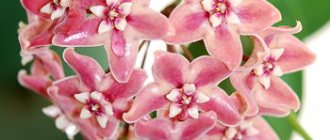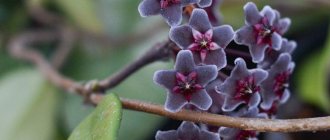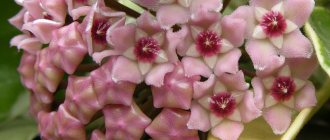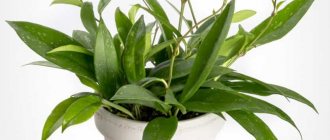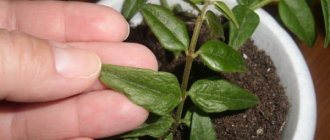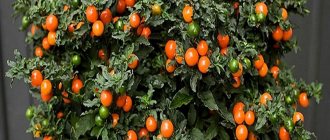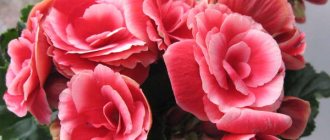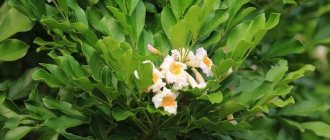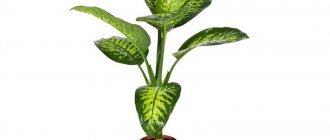Plants » Flowers
0
332
Article rating
Larisa Kosterina
One way to obtain plant varieties is through cross-pollination. This is usually a purposeful action. But in 1994, only chance gave a new variety - the charming Hoya Matilda.
Hoya Matilda photo
Characteristics of the variety
Breeding history
In the greenhouse of the Belgian botanist Begine, Hoya Carnosa and Hoya Serpens bloomed nearby.
Outside their natural habitat, pollination is difficult. The Belgian developed an unusual pod on one of the flowers, which gave seeds to 2 new plants. One of the varieties was named after the Queen of Belgium, Mathilde.
The full name of the variety is hoya cv. Mathilde splash. Here cv. = cultivar indicates its hybrid origin. Silvery specks on the leaves, similar to drops of water, led to the addition of splash.
External parameters
The homeland of the Hoyaceae family is Southeast Asia and Australia. During the selection process, this ornamental plant became more compact.
In apartments where there is a shortage of space, Hoya struggles for life on the verticals. It can be cultivated on supports as a climbing plant or as a hanging plant. Hoya Mathilde splash has:
- stems up to 1.5 mm thick;
- oval leaves 3 cm long and 2 cm wide;
- flower umbrellas consisting of 15-20 flowers. The corolla of the flower is white or pale pink, 2 cm in diameter. The crown is white with a red center.
Under favorable conditions, flowering lasts all year round.
Landing rules
Ceramic and clay pots are most suitable for planting, allowing the roots to “breathe”. Initially, it is necessary to plan the installation of future supports if you plan to grow vines. For an ampel style - the presence of hanging points for flowerpots.
Selection of soil and location
All types of hoya are succulents. And according to the growing conditions in the wild, they are close to epiphytes. This explains why hoya does not like excess humidity. Only light, breathable soil is suitable for this flower. This will also reduce the risk of fungal diseases.
The best base for the substrate is expanded clay. You can also use perlite, sphagnum, and high-moor peat. Drainage is required.
Popular types with descriptions and photos
Variegata
This ornamental crop has interesting leaves. They are dark green along the edges and apple-colored in the middle. This type of Hoya bella is the most beautiful. The plant is no less attractive during flowering. But the culture grows slowly, and it is also demanding in terms of care.
Albomarginata
This plant has light leaves, the edges of which are almost white. Flowering is long and lush. The flowers are white with a lilac center inside.
Before purchasing Hoya, you should carefully familiarize yourself with all the growing conditions that are required for it. We suggest you read about the features of caring for such species as Carnosa, Publicalis (Silver Pink, Splash and Red varieties), Curtisi, Australis, Linearis, Kerry, Obscura, Lacunosa, Matilda and Lobby.
The necessary conditions
Hoya Matilda, although born in a Belgian greenhouse, considers the conditions of her ancestors - tropical rainforests - comfortable.
Humidity
Hoya easily tolerates short-term drought, but excess moisture in the soil is detrimental to the flower. The air humidity in the room should be moderate. In cool conditions, watering the plant should be reduced to a minimum.
Temperature
This evergreen vine is native to the tropics.
Best Temperature:
- in the spring-summer period for a flower - within 20-25 ° C;
- in autumn and winter it can be lowered to 15-18°, creating dormancy for the plant.
If Matilda is planned to bloom all year round, then the temperature in winter should not be lowered!
Lighting
In the wild, vines always grow in the shade of large trees. When determining a place in the room for the hoya, it is necessary to exclude its exposure to direct sunlight at noon. At the same time, a lack of light will have a detrimental effect on the appearance of the flower and the color of its foliage. Only good lighting will provide a bright silver speck (splash).
Window sills on the east or west side are well suited for placing vines. If it is north, illumination with phytolamps may be required.
Features of the plant
Flower plantings like a room temperature of 20 to 25°C. Hoya multiflora does not tolerate sudden drops and temperature fluctuations. It is not recommended to take it out onto the balcony, greenhouse or garden in the summer. Due to unstable temperatures, brown spots may appear on the flower, and the leaves will fall off.
If the bush is left in uncomfortable conditions for a long time, the plant may die. Feeding is carried out from mid-spring to the end of summer. The procedure is carried out once every 3-4 days. Purchased mineral fertilizers are best suited - micro, salt, nitrogen, phosphorus, potassium. The pet responds well with abundant flowering to nutritious fertilizers and fertilizing. Its propagation is carried out by cuttings. Stems are selected with two leaf pairs. Such cuttings grow well and take root well. A cutting with one internode can grow at home, but its establishment and flowering will occur much more slowly. For this procedure, it is necessary to select last year's shoots. The leaves of the flower also give roots, but such a bush will not grow and bloom. The cut stem must be placed in water at room temperature. After this, it is dipped into root and moist substrate. For good rooting and creating a greenhouse atmosphere, the planting is covered with a bottle or glass jar.
Multiflora will grow only after the entire space of the container is filled.
Care
Hoya Matilda splash is easy to care for. But in order to achieve regular and long-lasting flowering, this tropical plant needs to create certain conditions.
Hoya Matilda care
Feeding
Hoya is a slow growing vine with dense foliage. For growth and development, it requires the basic elements: nitrogen, phosphorus and potassium. They are contained in full-composition NPK mineral complexes in pre-calculated proportions.
Young plants need a high dose of nitrogen to form leaves; they are given a 2-1-2 or even 3-1-2 composition.
To stimulate flowering and during the dormant period, the proportion of nitrogen is reduced and fertilized with fertilizer in a concentration of 5-10-5.
Fertilizer is applied:
- during the growing season - 2 times a month;
- during rest - 1 time per month.
If you switch to a high phosphorus fertilizer about a month before your hoya blooms, you will ensure stunning displays of flowers!
Watering
Hoya liana prefers infrequent but intensive watering. In the intervals between water procedures, the top layer of soil should dry out by 3-4 cm. This ensures the necessary aeration of the plant’s root system. In the summer, the flower can be given a warm shower, simulating a tropical downpour.
The water temperature should not exceed 40°C. Such procedures are possible as long as the size of the plant allows it. In this case, the leaching of minerals from the substrate must be compensated for by subsequent feeding.
Transfer
Household vines require regular replanting to maintain their decorative properties. Young hoyas are replanted every year, adults - once every 3-4 years. This is done in the spring, before flowering begins, using the transshipment method without disturbing the earthen coma.
The new container should be slightly larger (2-3 cm) than the previous one. Otherwise, the hoya will develop the root system to the detriment of budding until it fills the container.
When replanting, the roots are inspected, removing diseased and damaged ones. They try to keep the soil level 1-2 cm below the edge of the walls.
Botanical description of Hoya Mathilde
- Class : dicotyledonous.
- Family : kutrovye.
- Genus : Hoya.
Hoya Mathilde (Hoya mathilde) is a hybrid of Hoya fleshy and Hoya serpentine, obtained in the 1990s.
The leaves are succulent and glossy, the stems are pubescent, the flowers are collected in dense umbrellas. The flowers are velvety, white with a slight greenish tint, in the center there is a ruby star with a yellow center, the flower size is 1-2 cm.
The smell of blooming Matilda is quite strong, sweet, reminiscent of a tulip. The leaves may have variations with light spots, such plants are called splash.
Reproduction methods
Seeds
Propagating hoya by seeds at home is a long, labor-intensive and unreliable process. And the result - the flowering of a young plant - will have to wait a long time. Therefore, these vines are propagated by vegetative methods.
Hoya Matilda splash photo
Cuttings
This is the most common propagation method. It is carried out like this:
- cut cuttings from the shoots of the previous year no more than 8 cm long with 2 pairs of leaves;
- remove milky juice with running water;
- cut the 2 bottom sheets;
- place the cuttings in water or immediately in a loose substrate - perlite or vermiculite;
- a greenhouse is built on top.
After 2-3 weeks, roots sprout from a node located in water or soil. After this, the sprout is transferred to a permanent place. This plant begins to bloom after about 4 years.
Air layering
According to their growing conditions, Hoya vines are close to epiphytes. They easily form aerial roots.
For reproduction:
- Remove the leaves from the node near the top of the long shoot;
- Pinned to the surface of the soil in a separate cup;
- Sprinkle the substrate on top. The end of the stem with the leaves should remain free (it is constantly kept moist);
- New roots will begin to grow in the buried node.
After rooting, the cuttings are separated from the mother plant and planted separately. The advantage of this method is that hoya can bloom as early as next year.
Planting home hoya with cuttings and caring for the plant
Planting hoya using apical or stem cuttings is carried out as follows: the cutting is placed in a plastic bag filled with a slightly moistened substrate so that the lower node is covered with soil. The bag is then placed horizontally, and after 10 days it will be possible to observe the appearance of roots.
You can do it differently by planting the cuttings in a flowerpot. Drainage is placed at the bottom of the container, then a substrate is placed into which the cutting goes deep, as in the previous version. To maintain moisture, a transparent plastic bag is placed loosely over the pot.
After 14-21 days, you can get a germinated cutting, ready for planting in a permanent place of growth in soil prepared using one of the previously described technologies.
Rooting in water is done like this. The container with the liquid is wrapped in foil on all sides, and holes are made in the top of the wrapper for the cuttings. Planting materials treated at will with Kornevin are lowered into the vessel so that the lower node is under water. A plastic bag is also placed loosely on the container (to allow free air flow). Roots will appear after 14 days. You need to transplant the cutting into the ground immediately, since the roots will become very fragile and may break off.
Diseases and pests
The main dangers for domestic hoya are fungal diseases and sucking insect pests.
| Diseases/pests | Treatment | Prevention |
Fungal diseases:
| Copper-containing preparations, primarily Bordeaux mixture. One of the modern drugs is phytosporin. | Elimination of high humidity and low temperatures. |
Sucking insects:
| Insecticides: Aktara, Aktofit, Confidor. Garden oil, laundry soap. | Introduction of quarantine for newly acquired plants, regular inspection of flowers for the presence of insects, egg laying, and cobwebs. |
Common problems encountered when growing Hoya Matilda:
| Problem | Cause |
| Leaf falling, leaves turning black and stems dying | Poorly drained soil, too low room temperature, watering with cold water. |
| Withering and dying of shoots | Excessive moisture or overfeeding with fertilizers, which makes the roots unable to absorb water due to soil salinity. |
| Root rot | Non-drying soil. |
| No flowering | Insufficient lighting, overfeeding with nitrogen, too drastic pruning |
Everything about the hoya is attractive. From its wonderful scent to its small clusters of white and pink fluffy flowers and tiny silver spotted leaves.
Grow Matilda in a pot on a small trellis or in a hanging basket and let it overflow the edge of the planter - you will get a delightful cascade of exquisite greenery that can decorate any interior.
